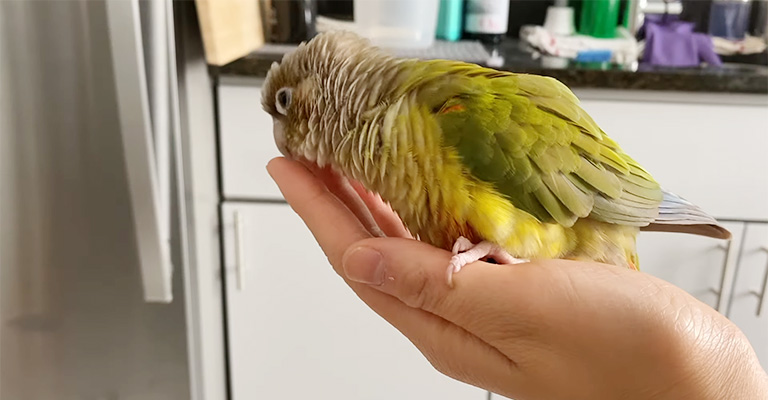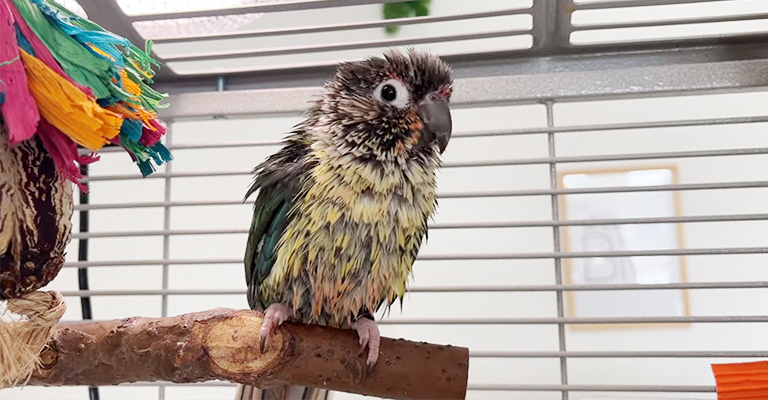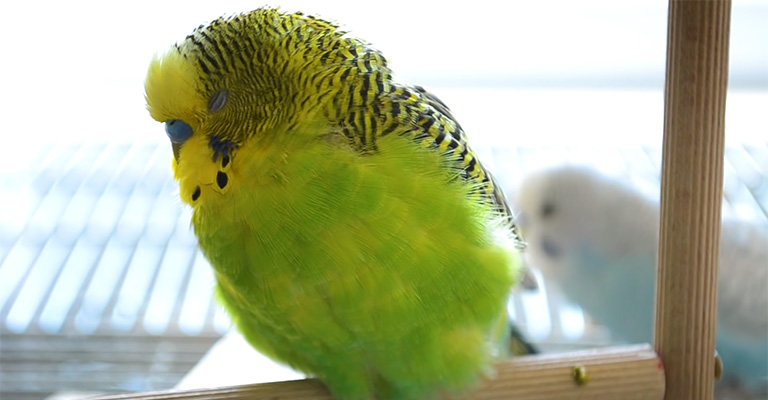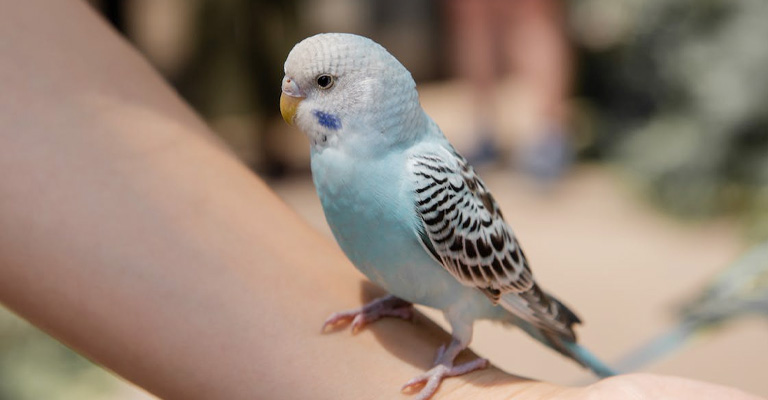In our modern kitchens, non-stick cookware has become a staple, making cooking and cleaning a breeze. However, an invisible threat lurks within these seemingly harmless pans—Teflon toxicity.
While these non-stick surfaces offer convenience to humans, they can spell disaster for our feathered companions. Bird enthusiasts and pet owners need to be aware of the insidious dangers that Teflon-coated cookware can pose to avian friends.
In this exploration, we delve into Teflon toxicity in birds – signs, causes, and treatment. In our shared journey of cohabitation with birds, it is our responsibility to ensure their safety and well-being.
From the smallest songbirds to majestic parrots, no bird is immune to the consequences of Teflon exposure. Join us on this journey to safeguard our feathered companions and ensure their safety in our homes.

Teflon Toxicity in Birds
Teflon poses a significant risk to pet birds and requires urgent attention. This exploration delves into the silent yet deadly world of Teflon toxicity in birds.
We unveil the subtle signs that serve as red flags, dissect the causes behind this hazardous phenomenon, and uncover the life-saving treatments that can make all the difference in a bird’s survival.
Signs of Teflon Toxicity in Birds
Signs of Teflon toxicity in birds can vary in severity, but they typically manifest as respiratory distress and other concerning symptoms. Here are common signs to watch for if you suspect Teflon exposure in your pet bird:
Respiratory Distress
Birds exposed to Teflon fumes often exhibit labored breathing, rapid or open-mouthed breathing, wheezing, or coughing.
Discharge and Lethargy
You may notice nasal discharge, which can be clear or tinged with blood, as well as watery eyes. Affected birds may become unusually inactive, weak, or reluctant to perch.
Loss of Appetite and Changed Behavior
A decrease in appetite or refusal to eat is a common sign. Birds may exhibit changes in behavior, such as increased agitation, restlessness, or a reluctance to move.
Head Bobbing
Some birds may display head bobbing, which is often associated with respiratory distress. In severe cases, birds can collapse or become paralyzed.
It’s crucial to recognize these signs promptly because Teflon toxicity can progress rapidly and become life-threatening. If you suspect your bird has been exposed to Teflon or is showing any of these symptoms, seek immediate veterinary care.
The quicker the intervention, the better the chances of a successful recovery for your feathered friend.
What Causes Teflon Toxicity in Birds?

Teflon toxicity in birds is caused by the inhalation of toxic fumes produced when polytetrafluoroethylene (PTFE), the substance used to make Teflon and other non-stick coatings, is heated to high temperatures.
These fumes can be extremely harmful to birds for several reasons:
Sensitivity to Fumes
Birds have highly efficient respiratory systems that make them exceptionally sensitive to airborne toxins. The fumes released by overheated Teflon are particularly harmful to their delicate lungs.
High Heat Degradation
When Teflon-coated cookware is subjected to temperatures above 500°F (260°C), it begins to break down, releasing toxic gases, primarily perfluorooctanoic acid (PFOA) and other noxious compounds. Birds can be affected by even lower temperatures.
Rapid Progression
Teflon toxicity can progress rapidly once birds are exposed to the toxic fumes. The damage can be severe and irreversible if not addressed promptly.
Small Living Spaces
Birds often share close living spaces with their human caregivers, making them more susceptible to Teflon fumes when cooking with non-stick cookware in the same household.
To prevent Teflon toxicity in birds, it’s essential to avoid overheating Teflon-coated pans or, even better, to opt for bird-safe alternatives like stainless steel or cast iron cookware.
Awareness of the risks and practicing responsible cooking habits can go a long way in protecting the health of pet birds.
Treatment of Teflon Toxicity in Birds

Treatment of Teflon toxicity in birds requires immediate and specialized care from a qualified avian veterinarian.
Teflon toxicity can progress rapidly and become life-threatening, so timely intervention is crucial. Here are some common steps involved in the treatment of Teflon toxicity in birds:
Remove the Bird from the Source
The first step is to remove the affected bird from the area where it was exposed to Teflon fumes.
Ensure the bird is placed in a well-ventilated, clean environment free from any potential sources of contamination.
Oxygen Therapy
Birds exposed to Teflon fumes often suffer from respiratory distress. Oxygen therapy may be administered to alleviate breathing difficulties and provide essential oxygen to the bird’s tissues.
Supportive Care
Supportive care may include administering fluids to prevent dehydration, maintaining proper body temperature, and providing supplemental nutrition if the bird is not eating.
Medications
Your avian veterinarian may prescribe medications to address specific symptoms, such as anti-inflammatory drugs to reduce lung inflammation or antibiotics if there is a risk of secondary bacterial infections.
Diagnostic Tests
Diagnostic tests, such as blood work and radiographs (X-rays), may be conducted to assess the extent of damage and monitor the bird’s progress.
Hospitalization
In severe cases, hospitalization may be necessary to provide intensive care and monitoring. Birds with advanced Teflon toxicity may require extended hospital stays.
Recovery and Follow-Up
Depending on the severity of the exposure and the bird’s response to treatment, the recovery period can vary. Close follow-up with the avian veterinarian is essential to monitor the bird’s progress and adjust treatment as needed.
It’s important to note that the prognosis for birds with Teflon toxicity can be guarded, especially in severe cases.
Prevention is the best approach, so bird owners should be vigilant in avoiding exposure to Teflon fumes and creating a safe environment for their avian companions.
How to Protect Your Bird from Teflon Toxicity?

Protecting your bird from Teflon toxicity is crucial, as prevention is the best way to ensure their safety. Here are essential steps to protect your feathered friend:
Avoid Teflon and Non-Stick Cookware
The most effective way to prevent Teflon toxicity is to avoid using Teflon-coated or non-stick cookware in your home. Opt for bird-safe alternatives like stainless steel, glass, cast iron, or ceramic cookware.
Ventilation
Ensure proper ventilation in your kitchen while cooking. Use exhaust fans and open windows to help disperse cooking fumes.
Cook in a Separate Area
If you must use non-stick cookware, do so in a separate, well-ventilated room away from your bird’s living area. Never use these pans near your bird’s cage.
Cook at Low Temperatures
If you choose to use non-stick cookware, cook at low temperatures and avoid overheating the pans, as this is when Teflon releases toxic fumes.
Using lids or covers on pots and pans can help contain cooking fumes and reduce the risk of exposure.
Regular Maintenance
Ensure that your cookware is in good condition. Scratched or damaged non-stick surfaces are more likely to release toxic fumes when heated.
Awareness
Educate all members of your household about the dangers of Teflon and the importance of following these safety guidelines.
Emergency Plan
Have a plan in case of accidental exposure. Know the location of your nearest avian veterinarian and be prepared to seek immediate medical attention if you suspect Teflon exposure.
Air Purifiers
Consider using high-efficiency particulate air (HEPA) filters or air purifiers with activated carbon to help remove airborne toxins in your home.
Regular Cookware Inspection
Periodically inspect your cookware for signs of wear and tear. Replace any pots or pans with damaged non-stick coatings to prevent potential Teflon exposure.
Cooking Methods
Choose cooking methods that minimize the use of high heat and frying, as these activities are more likely to release Teflon fumes. Baking, steaming, and simmering are safer alternatives.
Cooking Appliances
If you have concerns about your cookware, consider using alternative cooking appliances like toaster ovens, microwave ovens, or slow cookers that don’t require non-stick surfaces.
By following these precautions and being vigilant about the use of non-stick cookware, you can create a safe environment for your pet bird and reduce the risk of Teflon toxicity.
Remember that birds are highly sensitive to airborne toxins, so prevention is key to their well-being.
FAQs
While Teflon is a well-known source of toxic fumes, other non-stick coatings can also release harmful gases when overheated. It’s best to avoid all non-stick cookware to ensure your bird’s safety.
Non-stick coatings can be present in various kitchen appliances. It’s essential to exercise caution and ensure proper ventilation when using these appliances to prevent potential exposure to fumes.
The effects of Teflon toxicity can vary depending on the severity of exposure and the bird’s health. Long-term effects may include chronic respiratory issues, reduced lung function, or even permanent damage to the respiratory system.
Birds exposed to Teflon fumes can recover with prompt and appropriate veterinary treatment.
However, the prognosis depends on the level of exposure and how quickly intervention occurs. Early detection and treatment significantly improve the chances of recovery.
Yes, there are air purification systems designed for bird owners that can help reduce airborne toxins, including those from cooking.
Look for high-quality air purifiers with HEPA filters and activated carbon, which can be effective in removing harmful particles and gases from the air in your bird’s environment.
Conclusion
Teflon toxicity in birds is a pressing issue that demands our vigilance and care as avian enthusiasts and pet owners.
The signs of Teflon exposure, from subtle respiratory distress to devastating outcomes, serve as a stark reminder of the hidden dangers lurking in our kitchens.
Understanding the causes, which stem from the release of toxic fumes when Teflon pans are overheated, empowers us to take preventive measures.
By simply avoiding overheating Teflon-coated cookware or opting for bird-safe alternatives, we can protect our beloved feathered companions from harm.
Should an unfortunate incident occur, prompt action and treatment can be life-saving.
Consulting an avian veterinarian and providing immediate supportive care can make all the difference in a bird’s recovery.
By staying informed and taking proactive steps, we can minimize the risk of Teflon toxicity and provide a safe and nurturing environment for our cherished avian friends.